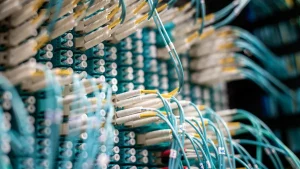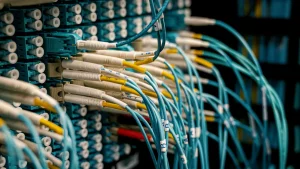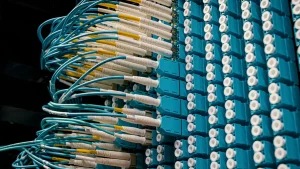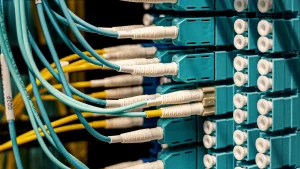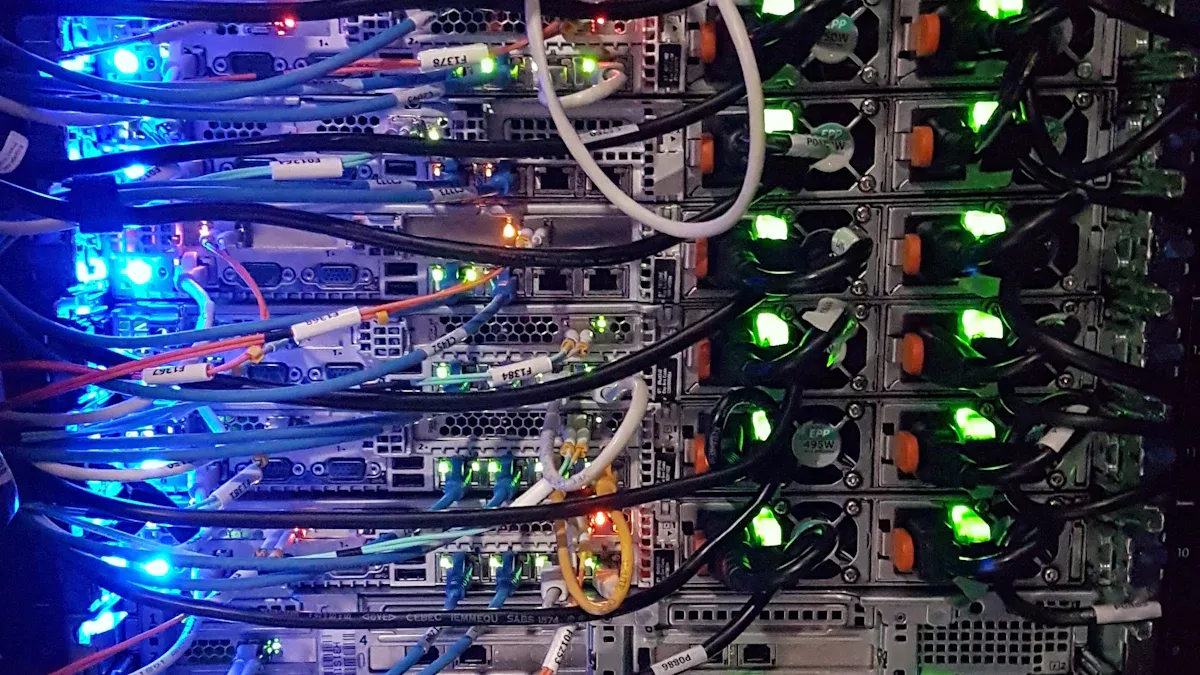
The 40G QSFP+ LR4 10km transceiver for SMF serves as a crucial component in modern networking, enabling high-speed data transmission over long distances. Selecting the right transceiver, such as the 40G QSFP+ PSM LR4 10km optical transceiver, is essential, as it directly impacts network performance and reliability. Key factors to consider include compatibility with existing equipment, adherence to Multi-Source Agreement standards, and specific application needs.
The global market for 40G QSFP+ electrical port modules is growing significantly, driven by increased data center deployments. The market is projected to reach a size of $574 million by 2031, with a CAGR of 13.0%.
Key Takeaways
- Select the right transceiver based on your network’s distance requirements, with the 40G QSFP+ LR4 supporting up to 10 km.
- Ensure compatibility with existing equipment by checking specifications and adhering to Multi-Source Agreement standards.
- Consider the type of fiber optic cabling; use single-mode fiber for long distances and multimode fiber for short distances.
- Utilize Digital Optical Monitoring (DOM) features for real-time diagnostics and enhanced performance monitoring.
- Evaluate the total cost of ownership, including installation and maintenance, to make informed purchasing decisions.
- Prioritize quality and brand reputation when selecting transceivers to ensure reliability and support.
- Regularly update firmware and monitor environmental conditions to maintain optimal performance and device longevity.
- Understand the differences between transceiver types, such as the 40G QSFP+ LR4 and SR4, to choose the best fit for your specific application.
Understanding 40G QSFP+ LR4 Technology

Technical Specifications
The 40G QSFP+ LR4 10km transceiver for SMF is designed to meet specific technical requirements that ensure optimal performance in high-speed networking environments. Below is a summary of its key specifications:
| Specification | Value |
|---|---|
| Tx Wavelength | 4 WDM Separated 1310nm Lanes |
| Minimum Transmitting Power | Each Lane -4 dB |
| Maximum Transmitting Power | Each Lane 2.3 dB |
| Receiver Sensitivity | Each Lane -13.7 dBm |
| Receiver Overload | Each Lane 2.3 dBm |
| Transmitter Type | DFB Laser |
| Receiver Type | PIN photodiode |
| Power | +3.3V single power supply |
| Compliance | 802.3ba 40GBASE-LR4, CE, … |
Additional specifications include:
- Wavelength: 1270nm to 1330nm
- Reach: 10km
- Connector: LC
- Form Type: QSFP+
- Speed: 40GBase
- Environment: 0 to 70°C
- DOM: Digital Optical Monitoring support
These specifications highlight the transceiver’s capability to transmit data over long distances while maintaining high data rates.
How It Works
The operation of the 40G QSFP+ LR4 transceiver involves converting electrical signals into optical signals for efficient data transmission. The transceiver performs the following functions:
- It converts four 10G electrical signals into four optical wavelengths.
- These wavelengths are multiplexed onto a single fiber strand for transmission.
- On the receiving end, the process is reversed, where the optical signals are demultiplexed back into electrical signals.
The transceiver achieves this by utilizing four independent channels, each transmitting at 10 Gbps, resulting in a total data rate of 40 Gbps. The center wavelengths of the four channels are 1271, 1291, 1311, and 1331 nm. The transceiver features an LC Duplex connector for the optical interface and a 38-pin connector for the electrical interface.
Additionally, the 40G QSFP+ LR4 transceiver incorporates advanced thermal management capabilities to ensure efficient operation. It consumes approximately 3.5 watts of power and includes Digital Optical Monitoring (DOM) features for real-time diagnostics, enhancing compatibility with various platforms.
Key Applications of 40G QSFP+ LR4
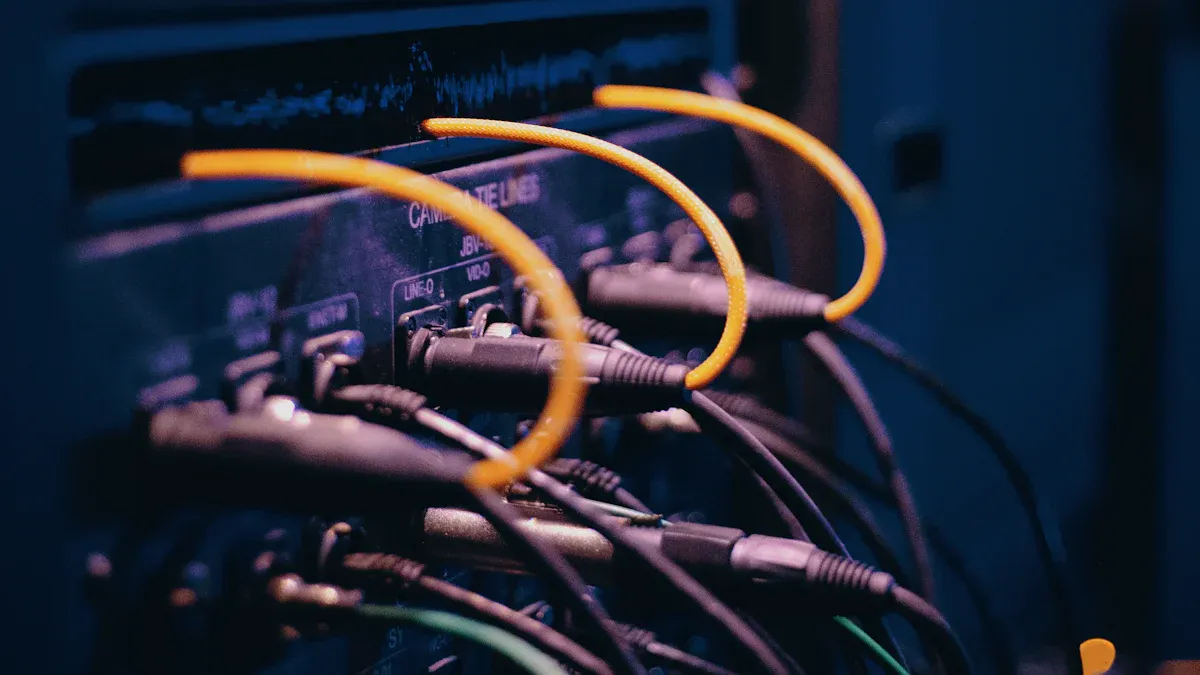
Data Centers
Data centers represent one of the primary environments where the 40G QSFP+ LR4 transceiver excels. Its compact design and high-density port configuration allow for multiple connections without consuming excessive space. This feature is crucial for data centers, where real estate is often at a premium.
The following benefits highlight the advantages of deploying 40G QSFP+ LR4 transceivers in data center environments:
| Benefit | Description |
|---|---|
| High-Density Port Configuration | Compact size allows for multiple connections without excessive space usage, crucial for data centers. |
| Hot-Pluggable Design | Enables insertion/removal without network disruption, simplifying maintenance and installation. |
| Efficient Network Scalability | Users can easily adjust network capacity by adding/removing modules, facilitating seamless expansion. |
| Reliable Connectivity | Robust design prevents accidental disconnections, ensuring stable data transmission. |
| Long-Range Data Transmission | Supports connections over long distances without performance loss, ideal for campus or remote locations. |
| Cost-Effective Solution | Reduces overall equipment costs by allowing module upgrades instead of full device replacements. |
Telecommunications
In telecommunications, the 40G QSFP+ LR4 transceiver plays a vital role in supporting high-speed data transmission. It features a four-channel design with two LC fiber connector jacks, enabling data rates of 40 Gbps over distances ranging from 10 to 20 km. This capability makes it suitable for various telecommunications applications.
Key functionalities include:
- The transceiver converts four channels of 10.3125 Gb/s electrical data into four CWDM optical signals.
- It multiplexes these signals into a single channel for 40 Gb/s optical transmission.
- Designed for long-distance communication, it supports a range of up to 10 km.
Typical deployment scenarios in telecommunications include ISP interconnects, tiered backbone layers, and metro/campus aggregation.
Enterprise Networks
Enterprise networks also benefit significantly from the 40G QSFP+ LR4 transceiver. Its extended reach of up to 10 km over Single-Mode Fiber (SMF) makes it ideal for enterprise campuses and metro networks. The technology utilizes CWDM wavelengths ranging from 1271 to 1331 nm, ensuring compatibility with carrier-grade equipment.
The following features illustrate its role in enterprise network upgrades:
| Feature | Description |
|---|---|
| Reach | Up to 10 km over Single-Mode Fiber (SMF) |
| Technology | CWDM wavelengths (1271–1331 nm) |
| Use case | Enterprise campuses, metro networks, DCI |
| Advantages | Extended reach, lower dispersion, compatible with carrier-grade equipment |
| Applications | High-density data center deployments, mission-critical network infrastructure, 24/7 operation environments |
The 40G QSFP+ LR4 transceiver thus serves as a versatile solution across various sectors, enhancing connectivity and performance in modern networking environments.
Compatibility Considerations
Equipment Compatibility
When selecting a 40G QSFP+ LR4 transceiver, ensuring compatibility with existing equipment is crucial. Various brands and models support this transceiver type, enhancing flexibility in deployment. Here are some notable compatible options:
- Cisco QSFP-40G-LR4 Compatible 40GBase-LR4 QSFP+ 1310nm 10km DOM Duplex LC SMF Optical Transceiver Module
- Arista QSFP-40G-LR4-A-FLT
- Brocade-Foundry 40G-QSFP-LR4-FL
- Chelsio SM40G-LR-FL
- Dell 407-BBGN-FL
- Juniper JNP-QSFP-40G-LR4-FLT
Choosing compatible components ensures data integrity and optimal performance. Additionally, monitoring environmental conditions can help maintain device longevity. Regular firmware updates also enhance compatibility and performance metrics, allowing for seamless integration into existing systems.
Network Infrastructure
The existing network infrastructure significantly impacts the performance of 40G QSFP+ LR4 transceivers. Understanding how various aspects of the infrastructure interact with the transceiver can lead to better deployment strategies. The following table summarizes key considerations:
| Aspect | Evidence |
|---|---|
| Long-range connectivity | The LR4 wavelength enables communication over distances up to 10 kilometers, ensuring seamless connectivity in large networks. |
| Flexible deployment options | The LR4 wavelength allows for connecting distant devices without extensive infrastructure changes. |
| Compatibility with existing infrastructure | The transceiver is designed to integrate smoothly into current systems, minimizing deployment disruptions. |
These factors highlight the importance of assessing the current network setup before deploying the 40G QSFP+ LR4 transceiver. By ensuring compatibility with both equipment and infrastructure, organizations can maximize the efficiency and reliability of their networking solutions.
Pricing Insights
Cost Factors
When evaluating the pricing of 40G QSFP+ LR4 transceivers, several cost factors come into play. Understanding these factors can help organizations make informed purchasing decisions. Key considerations include:
- Brand Reputation: Established brands like Cisco often command higher prices due to perceived reliability and compatibility. Users frequently associate these brands with quality and support.
- Warranty Offerings: Transceivers with longer warranties typically carry higher price tags. This pricing reflects the assurance of quality and ongoing support.
- Performance Specifications: Higher performance transceivers, which offer superior data rates and transmission distances, generally come at a premium. Organizations should assess their specific performance needs against the associated costs.
- Durability and Compliance: Transceivers designed to withstand harsh operating conditions may justify higher prices. For example, the QSFP-40G-PSM-LR4 is compliant with industry standards, enhancing its value based on performance and reliability.
- Compatibility: Products like FluxLight’s QSFP-40G-LR4-FLT, which are factory pre-programmed for seamless integration, may be priced higher due to their broader compatibility with OEM and third-party transceivers.
The following table summarizes the average price range for a popular model in the market:
| Product | Price |
|---|---|
| QSFP+ 40G PSM LR4 1310nm 10km Optical Transceiver | $119.00 |
Additionally, some models, such as the Cisco QSFP-40G-LR4-S-20, do not specify a price, indicating variability based on vendor and market conditions.
Budgeting for Transceivers
Budgeting for 40G QSFP+ LR4 transceivers requires careful planning. Organizations should consider both initial costs and long-term value. Here are some tips for effective budgeting:
- Assess Network Needs: Determine the required performance specifications and compatibility with existing infrastructure. This assessment will guide the selection of appropriate transceivers.
- Factor in Total Cost of Ownership: Consider not only the purchase price but also installation, maintenance, and potential upgrades. A lower-priced transceiver may incur higher costs over time if it requires frequent replacements or lacks compatibility.
- Prioritize Quality: Investing in higher-quality transceivers can lead to better performance and reliability. This investment often pays off through reduced downtime and maintenance costs.
- Explore Bulk Purchase Options: Organizations may benefit from bulk purchasing discounts. Engaging with suppliers for volume pricing can lead to significant savings.
By understanding the cost factors and budgeting effectively, organizations can optimize their investments in 40G QSFP+ LR4 transceivers, ensuring they meet their networking needs without overspending.
Deployment Scenarios
Long-Distance Connections
The 40G QSFP+ LR4 transceiver excels in long-distance connections, making it a preferred choice for various applications. This transceiver supports a maximum distance of 10 kilometers over single-mode fiber (SMF). Its design integrates four lasers into one LC interface, allowing for efficient multiplexing onto a single optical fiber. This capability significantly enhances data transmission over extended distances.
Key advantages of using the 40G QSFP+ LR4 for long-distance connections include:
- Extended Reach: The transceiver is suitable for applications requiring up to 10 km reach, ensuring reliable connectivity across large networks.
- Cost-Effectiveness: Compared to the 40G LR4 PSM optical module, which necessitates eight single-mode fibers for the same distance, the 40G QSFP+ LR4 only requires two single-mode fibers. This reduction in fiber count leads to lower installation and maintenance costs.
- Performance: The transceiver maintains high data rates while supporting long-distance transmission, making it ideal for interconnecting data centers or linking remote locations.
In contrast, other transceiver types, such as the 40G SR4, are designed for short-distance transmission, typically limited to 150 meters over multimode fiber. This limitation restricts their use in scenarios where long-range connectivity is essential.
Short-Distance Connections
While the 40G QSFP+ LR4 is optimized for long-distance applications, it can also serve short-distance connections effectively. However, organizations often prefer other transceiver types for these scenarios. The 40G SR4, for example, is specifically designed for short-distance transmission within data centers.
Benefits of using the 40G SR4 for short-distance connections include:
- Higher Density: The SR4 transceiver can support multiple connections in a compact space, making it ideal for high-density environments.
- Cost Efficiency: For short distances, the SR4 typically offers a more economical solution than the LR4, as it utilizes multimode fiber, which is generally less expensive than single-mode fiber.
- Simplicity: The SR4’s design allows for straightforward installation and integration into existing data center infrastructure.
Comparing with Other Transceivers
40G QSFP+ SR4
The 40G QSFP+ SR4 transceiver serves a different purpose compared to the 40G QSFP+ LR4. It primarily targets data center environments that utilize multimode fibers. Below is a comparison of their key features:
| Feature | 40G QSFP+ SR4 | 40G QSFP+ LR4 |
|---|---|---|
| Application | Data center for multimode fibers | Data center for single mode fibers |
| Transmission Distance | 100m (OM3), 150m (OM4) | Up to 10KM |
| Wavelength | 4x850nm | 1271nm, 1291nm, 1311nm, 1331nm |
| Fiber Type & Connector | Multimode, MPO/MTP connector | Single mode, duplex LC connector |
| Working Principle | Converts electrical to optical signals using laser arrays | Uses multiplexer and demultiplexer for signal transmission and restoration |
The 40G QSFP+ SR4 excels in short-distance applications, making it ideal for high-density environments where space is limited. Its ability to transmit data over multimode fiber allows for cost-effective installations in data centers.
100G QSFP28 LR4
The 100G QSFP28 LR4 transceiver represents a significant upgrade over the 40G QSFP+ LR4. It offers higher data rates and extended reach, making it suitable for modern networking demands. Here are some of its key features:
| Feature | 100G QSFP28 LR4 | 40G QSFP+ LR4 |
|---|---|---|
| Data Rate | 100 Gbps | 40 Gbps |
| Transmission Distance | Up to 10KM | Up to 10KM |
| Wavelength | 4x1310nm | 1271nm, 1291nm, 1311nm, 1331nm |
| Fiber Type & Connector | Single mode, duplex LC connector | Single mode, duplex LC connector |
| Applications | Data centers, enterprise networks | Data centers, telecommunications |
The 100G QSFP28 LR4 provides a robust solution for organizations looking to future-proof their networks. Its higher data rate allows for increased bandwidth, accommodating the growing demand for data transmission.
Advantages and Disadvantages
When comparing the 40G QSFP+ LR4 with other transceivers, several advantages and disadvantages emerge:
| Feature | QSFP-40G-LR4 | QSFP-40G-PLR4 |
|---|---|---|
| Wavelength | 1271 nm, 1291 nm, 1311 nm, 1331 nm | 4×1310nm |
| Transmission Distance | Up to 10km | Up to 10km |
| Interoperability | Interoperates with SFP+ CWDM | Interoperates with 10GBASE-LR (10km) |
| Cable Type | 9um SM fiber | 4×10G mode with breakout cables |
The 40G QSFP+ LR4 offers a balance of performance and cost, making it suitable for various applications. However, organizations may find that the 40G QSFP+ SR4 is more appropriate for short-distance needs, while the 100G QSFP28 LR4 is better for high-capacity requirements. Each transceiver has its unique strengths, allowing organizations to choose based on their specific networking needs.
Choosing the Right 40G QSFP+ LR4 10km Transceiver for SMF
Evaluating Distance Requirements
When selecting a 40G QSFP+ LR4 10km transceiver for SMF, evaluating distance requirements is crucial. The LR4 module is specifically designed for high-speed optical connections over single-mode fiber. It effectively operates over distances of up to 10 kilometers, ensuring reliable data transmission without signal degradation.
Organizations must consider the following factors when assessing distance requirements:
| Feature | Description |
|---|---|
| Compatibility | Ensure compatibility with Cisco® compatible 40GBase QSFP+ transceivers. |
| Maximum Distance | The transceiver supports distances up to 10 km using single-mode fiber (SMF). |
| Data Rate | It provides an aggregate bandwidth of 40 Gbps. |
| Compliance | The transceiver is 100% compliant with the Multi-Source Agreement (MSA). |
| Functionality | Each lane operates at 10.3125 Gbps, allowing for efficient data handling. |
By understanding these factors, organizations can make informed decisions that align with their networking needs. The 40G QSFP+ LR4 10km transceiver for SMF is an excellent choice for applications requiring long-distance connectivity.
Assessing Fiber Optic Cabling
Assessing fiber optic cabling is another critical step in deploying the 40G QSFP+ LR4 10km transceiver for SMF. Proper cabling ensures optimal performance and reliability. Here are some best practices to consider:
- Use Compatible Components: Ensure that cables and networking devices meet or exceed the specifications for QSFP-40G. This compatibility maintains data integrity and performance.
- Monitor Environmental Conditions: Maintain specified temperature and humidity levels. Excessive heat or moisture can impact device longevity and performance.
- Regular Firmware Updates: Keep network devices updated with the latest firmware. This practice enhances compatibility and performance metrics.
- Implement Link Monitoring: Utilize digital diagnostic monitoring (DDM) features regularly. This allows for proactive maintenance and issue resolution.
By following these best practices, organizations can maximize the effectiveness of their 40G QSFP+ LR4 10km transceiver for SMF installations. Proper cabling and monitoring contribute significantly to the overall health of the network.
In summary, selecting the right 40G QSFP+ LR4 transceiver involves careful consideration of various factors. Key aspects include transmission distance, wavelength, cable type, and connector type.
Key Takeaways for Network Professionals:
Aspect Description Transmission Distance Choose based on the required distance; options include 100m, 150m, 300m, 1km, 2km, etc. Wavelength Ensure the transceiver operates within the correct wavelength range for your network. Cable Type Match the transceiver with appropriate cables; single-mode for long distances, OM3/OM4 for short. Connector Type Typically uses MTP or LC connectors; some special types may use MPO interfaces. Additional Features Consider features like Digital Optical Monitoring (DOM) for enhanced performance monitoring.
Informed decision-making significantly impacts network performance and cost efficiency. Assessing network requirements ensures compatibility with existing systems and optimal performance. Organizations should evaluate their specific needs to make the best choice for their networking environment.
FAQ
What is a 40G QSFP+ LR4 transceiver?
A 40G QSFP+ LR4 transceiver is a high-speed optical module designed for 40 Gbps data transmission over single-mode fiber. It supports distances up to 10 kilometers, making it ideal for data centers and telecommunications.
How does the 40G QSFP+ LR4 differ from the 40G QSFP+ SR4?
The 40G QSFP+ LR4 is optimized for long-distance transmission over single-mode fiber, while the 40G QSFP+ SR4 is designed for short distances using multimode fiber. The LR4 supports up to 10 km, whereas the SR4 typically supports up to 150 meters.
What applications benefit from using the 40G QSFP+ LR4?
Key applications include data centers, telecommunications, and enterprise networks. Its long-range capabilities make it suitable for interconnecting remote locations and enhancing network performance.
How do I ensure compatibility with my existing equipment?
Check the specifications of your current networking devices. Ensure they support the 40G QSFP+ LR4 transceiver and adhere to Multi-Source Agreement standards for seamless integration.
What factors influence the pricing of 40G QSFP+ LR4 transceivers?
Pricing is influenced by brand reputation, warranty offerings, performance specifications, durability, and compatibility. Higher-quality transceivers may come at a premium but often provide better long-term value.
Can I use the 40G QSFP+ LR4 for short-distance connections?
While the 40G QSFP+ LR4 can function for short distances, it is not the most cost-effective option. For short-distance applications, consider using the 40G QSFP+ SR4, which is optimized for such scenarios.
What maintenance practices should I follow for the 40G QSFP+ LR4?
Regularly monitor environmental conditions, perform firmware updates, and utilize Digital Optical Monitoring (DOM) features. These practices help maintain performance and extend the lifespan of the transceiver.
How do I choose the right transceiver for my network needs?
Evaluate your distance requirements, assess fiber optic cabling, and consider compatibility with existing infrastructure. Understanding these factors will guide you in selecting the most suitable transceiver for your network.
